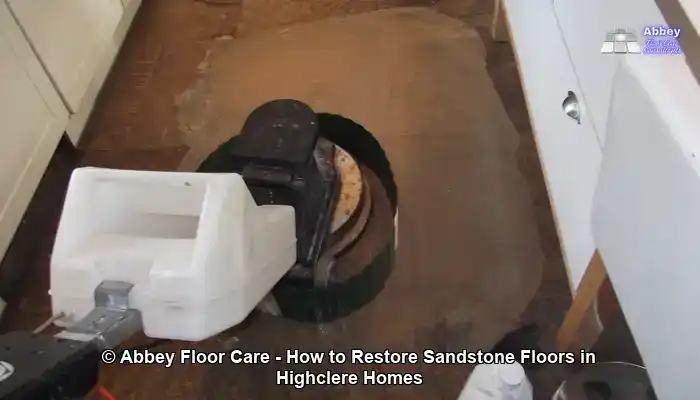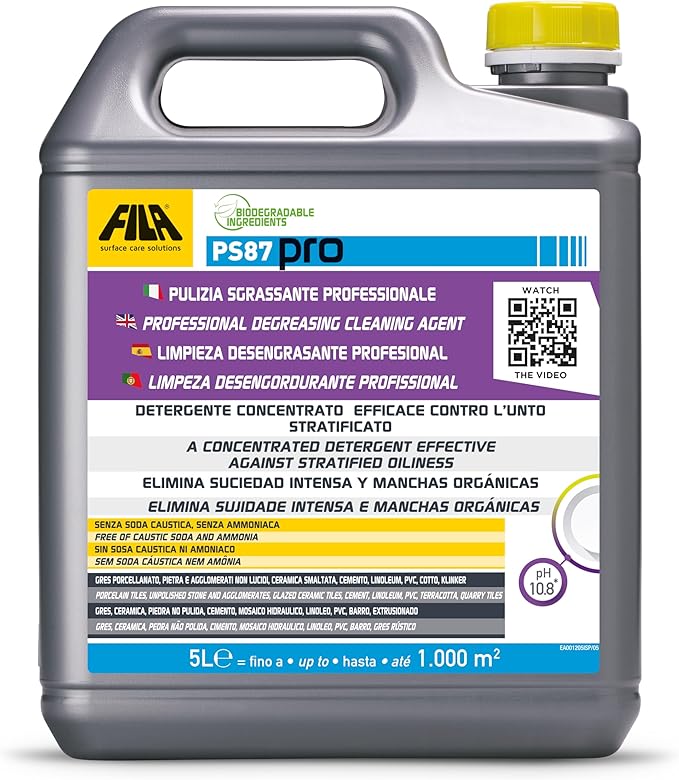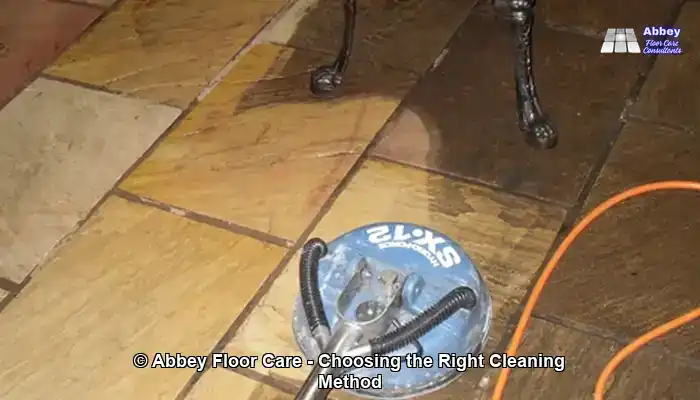
How to Restore Sandstone Floors in Highclere Homes
Last Updated on November 14, 2025 by David
Key takeaways from the article “How to Restore Sandstone Floors in Highclere Homes”
- Sandstone is highly porous and sensitive, requiring gentle, stone-safe cleaning methods to avoid etching or erosion.
- pH-neutral cleaners are ideal for routine care, while alkaline solutions may be used for deeper soiling—always followed by thorough rinsing and resealing.
- Topical sealers are effective when properly maintained, offering enhanced colour and protection, especially in high-traffic or decorative areas.
- Restoration involves careful surface prep, safe agitation, and residue-free rinsing, followed by sealing to protect against future staining.
- Regular maintenance with soft tools and prompt spill response helps preserve the finish and reduces the frequency of deep-cleaning cycles.
What Makes Sandstone Unique

Composition and Porosity
Sandstone is a sedimentary stone formed from compacted sand and mineral particles. Its natural porosity means it can absorb moisture and stains if left unsealed. The surface may appear smooth or textured depending on how it was cut and finished, but all sandstone floors share one trait: they require gentle, stone-safe care to preserve their integrity.
Common Issues in Highclere Homes
In Highclere and surrounding areas, sandstone floors are often found in older properties and period homes. Over time, exposure to foot traffic, cleaning chemicals, and seasonal moisture can lead to surface wear, patchy discolouration, and loss of sealant. Because sandstone is softer than granite or slate, it is more prone to erosion and needs regular attention to maintain its appearance and function.
Pro Tip: We recommend these products for daily Sandstone maintenance cleaning.

Fila Pro Floor Cleaner
|

FILA PS87 PRO
|

Vileda H2PrO Spin Mop System
|
Signs Your Sandstone Floor Needs Restoration

Surface Wear and Discolouration
Over time, sandstone floors can lose their natural colour and texture due to foot traffic, cleaning residues, and exposure to moisture. If the surface looks patchy, dull, or uneven, it may indicate that the protective layer has worn away, allowing the stone to absorb dirt and liquids more readily.
Loss of Sealant Protection
When sealant breaks down, sandstone becomes more porous and vulnerable to staining. You might notice water soaking into the surface rather than beading up. This indicates that the floor is no longer protected and needs resealing as part of the restoration process.
Slippery or Uneven Texture
Sandstone should feel firm underfoot with a consistent texture. If areas become slippery, powdery, or rough, it may be due to surface erosion or residue buildup. These changes often signal that the floor needs deep-cleaning and resealing to restore its safety and appearance.
Choosing the Right Cleaning Method

When pH-Neutral Cleaners Are Enough
For lightly soiled sandstone floors, a pH-neutral cleaner is often sufficient. These products lift surface dirt without affecting the stone’s mineral structure or sealant. They’re ideal for regular maintenance and safe to use on sealed or unsealed sandstone, provided the soil load is minimal.
Using Alkaline Cleaners for Heavy Soiling
When sandstone has absorbed oils, grime, or organic residues, especially in kitchens or entryways, a stronger alkaline cleaner may be needed. These solutions emulsify embedded soils and help release them from the porous surface. However, they must be rinsed thoroughly to prevent residue buildup. If the cleaner requires extended dwell time, resealing the floor afterwards is recommended to restore protection and prevent future staining.
Avoiding Acidic or Abrasive Products
Acidic cleaners, including vinegar or limescale removers, can etch sandstone and cause permanent damage. Abrasive powders and stiff brushes may scratch the surface or erode softer areas. Always choose stone-safe products and tools that clean effectively without compromising the floor’s integrity.
Step-by-Step Sandstone Floor Restoration
Surface Preparation and Dust Removal
Begin by clearing the area and removing any loose debris with a soft-bristle broom or a vacuum set to hard-floor mode. Avoid dragging furniture or using metal-edged tools, as these can scratch or chip the stone. If the floor has old polish or residue, consider using a stone-safe stripper before cleaning.
Applying the Cleaner and Agitating Safely
Choose a suitable cleaner based on the soil level. For general grime, a pH-neutral solution is ideal. For heavy contamination, use an alkaline cleaner diluted according to the label instructions. Apply the solution evenly and allow it to dwell for 5 to 15 minutes. Agitate gently with a white pad or soft brush to lift embedded dirt without damaging the surface.
Rinsing and Drying Without Residue
Rinse thoroughly with clean water, using a wet vacuum or multiple mop passes to remove all residues. Leftover cleaner can leave streaks or dull the finish. Once rinsed, allow the floor to dry entirely before assessing whether sealing or polishing is needed. A dry microfiber mop can help speed up the process and prevent water spots.
Sealing Sandstone for Long-Term Protection
Types of Sealers: Impregnating vs Topical
Impregnating sealers penetrate the surface of sandstone and protect it from within, offering invisible resistance to moisture and stains. These are ideal for homeowners who prefer a natural matte finish. Topical sealers, by contrast, form a protective layer on the surface and can enhance colour or add a satin or glossy sheen. When properly maintained and topped up, topical sealers are a valid option for high-traffic areas or decorative finishes.
How to Apply Sealer Correctly
Before sealing, ensure the floor is immaculate and dry. Apply the sealer evenly using a lint-free cloth, sponge, or applicator pad. Work in small sections and allow the product to absorb for the recommended time. Wipe away any excess to avoid streaks or residue. Some sealers may require a second coat, especially on more porous or weathered stone.
When to Reseal and How Often
Most sandstone floors benefit from resealing every 2 to 4 years, depending on foot traffic and moisture exposure. In kitchens, hallways, or entrances, resealing may be needed more frequently. A simple water-drop test can help: if water soaks in rather than beads up, it’s time to reseal. Regular inspection ensures the floor stays protected and easier to clean.
Enhancing Appearance and Safety
Colour-Enhancing Sealers
If your sandstone floor looks faded or washed out, a colour-enhancing sealer can deepen its natural tones and bring out the stone’s character. These sealers darken the surface slightly and highlight the variation in grain and mineral content. They’re especially effective on weathered or pale sandstone, but should only be applied after a thorough cleaning and drying period.
Improving Slip Resistance
In areas prone to moisture—like kitchens, bathrooms, or entryways—slip resistance is a key safety factor. Some sealers include anti-slip additives, or you can apply a separate non-slip treatment over the sealed surface. Always test in a small area first to ensure the finish remains visually appealing and easy to maintain.
Buffing and Polishing Options
While sandstone is not typically polished to a high gloss like marble, light buffing with a soft pad can improve its appearance and feel underfoot. For a subtle sheen, use a stone-safe polishing compound designed for honed finishes. Avoid wax-based products, which can trap dirt and create uneven shine over time.
Maintenance Tips for Highclere Homes
Weekly and Monthly Routines
To keep sandstone floors looking their best, dry mop regularly with a microfiber pad to remove dust and grit. For weekly cleaning, use a diluted pH-neutral cleaner and avoid soaking the floor. Monthly, inspect high-traffic areas for wear and reapply cleaner as needed. Avoid over-wetting, which can weaken sealants over time.
Best Tools for Ongoing Care
Flat microfiber mops are ideal for sandstone because they trap fine particles without scratching the surface. Avoid sponge mops, which can push dirt into the pores. For larger areas, consider a spray mop with refillable cartridges that allow controlled application of stone-safe solutions. Always rinse mop heads thoroughly after use to prevent residue buildup.
Handling Spills and Stains Quickly
Blot spills immediately using a soft cloth or paper towel. Do not rub, as this can spread the stain. For oily or coloured spills, apply a small amount of stone-safe cleaner and rinse with clean water. If a stain persists, use a baking soda and water poultice, but test first to ensure it won’t affect the finish. Timely action prevents permanent marks and keeps the floor looking fresh.
FAQs About Sandstone Floor Restoration
Can I Use Steam Cleaners?
It’s best to avoid steam cleaners on sandstone. The high heat and moisture can weaken sealants and drive water deep into the stone’s pores, potentially causing long-term damage. Stick to stone-safe liquid cleaners and gentle agitation for deep cleaning.
What If My Floor Is Already Damaged?
If your sandstone floor has deep stains, scratches, or surface erosion, cleaning alone may not be enough. In these cases, professional honing or resurfacing may be required to restore the stone’s appearance. Once repaired, sealing helps prevent future damage and makes maintenance easier.
How Long Does Restoration Last?
With proper sealing and maintenance, a restored sandstone floor can stay in excellent condition for several years. High-traffic areas may need touch-ups or resealing every 2 to 3 years, while lower-traffic zones can go longer. Regular care extends the time between major restorations.
Recent Posts:
We work throughout the country, just some of our work counties:
Copyright © 2025 Abbey Floor Care. Tile And Natural Stone Cleaning Consultants FAQ - Privacy Policy - Terms And Conditions
Abbey Floor Care is a participant in the Amazon Services LLC Associates Programme, an affiliate advertising programme designed to provide a means for websites to earn advertising fees by linking to Amazon.co.uk. As an Amazon Associate, we earn from qualifying purchases.